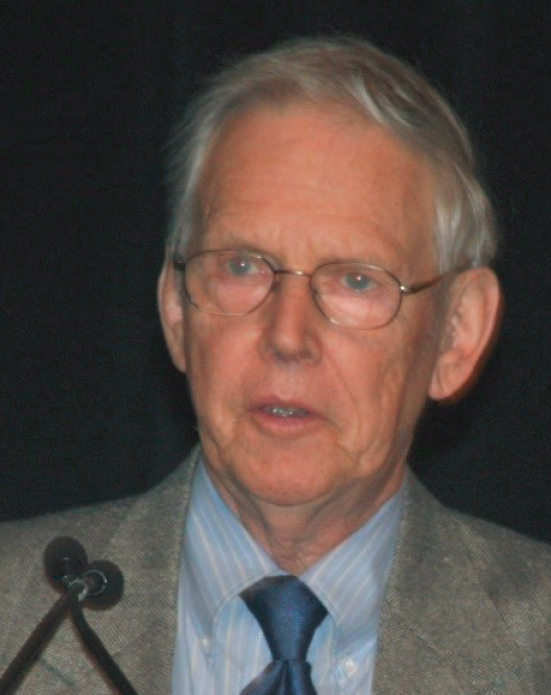
WILLIAM F. TINNEY
1921–2019
Elected in 1998
“For initiating sparse-matrix technology in electrical engineering and contributions to power-system computer applications.”
WILLIAM FRANK TINNEY passed away in Portland, Oregon, on April 14, 2019, three weeks before his 98th birthday. He is widely regarded as the father of modern computer solutions for electric power networks, where his pioneering contributions have had a profound influence on the growth of today’s power grids.
He was born May 5, 1921, to Elsie Frances (née Prohaska) and Irving L. Tinney. In 1943, after 2 years of electrical engineering at Oregon State College, he enlisted in the US Army and became a radar officer with training at MIT and Harvard. He then earned bachelor’s and master’s degrees from Stanford University.
Bill’s major groundbreaking work was carried out in the Systems Analysis Section at Bonneville Power Administration during his career there from 1950 to 1979. After he retired from BPA, he became an independent consultant to vendors of power systems software.
His seminal 1967 paper with John W. Walker revolutionized the solution of electric power networks via the then-novel exploitation of network matrix sparsity (which also inspired much work by the mathematical community on more general
sparse matrix solutions).1 In the electric power field, it became possible for the first time to solve large transmission network models rapidly and exactly. This launched a tidal wave of innovation to adapt this technology to mainstream software tools such as power flow, optimal power flow, state estimation, stability analysis, fault analysis, security dispatch, network reduction, and congestive market pricing. Bill collaborated in many of these pioneering adaptations, as reported in IEEE PES Transactions papers.
His innovations are as relevant today as ever. Practically every electric power system network computer program developed over the past 50 years is based on his sparse network solution approach. As computers have advanced, his techniques have made it possible to undertake more complex power network simulations and optimizations on larger and more detailed power grid models, involving many thousands or even millions of network solutions, and including critical real-time applications for economy and security. He has thus had immeasurable effect on the planning, design, and reliable operation of the world’s power grids, from individual utility-level to continentwide modeling.
While sparsity technology itself is central to all such network applications, two other specific breakthroughs must be emphasized: the 1967 Tinney and Hart paper on Newton power flow2 and the 1968 Dommel and Tinney paper on optimal power flow (OPF).3 Newton’s method soon became and remains the gold standard for power flow, and the OPF paper—the first clear and concise treatment of the problem—was voted the fifth-most important paper in 20th century power system analysis.4
________________
1 Tinney WF, Walker JW. 1967. Direct solutions of sparse network equations by optimally ordered triangular factorization. Proceedings of the IEEE 55(11):1801–09.
2 Tinney WF, Hart CE. 1967. Power flow solution by Newton’s method. IEEE Transactions on Power Apparatus and Systems PAS-86(11):1449–60.
3 Dommel HW, Tinney WF. 1968. Optimal power flow solutions. IEEE Transactions on Power Apparatus and Systems PAS-87(10):1866–76.
4 North American Power Symposium, 2000: High-impact papers in power engineering, 1900–1999.
Bill’s substantial work was recognized in a variety of ways. In 1976 he was designated an IEEE fellow, cited for “contributions to the application of digital computers to solve large power network problems.” Other honors include the IEEE Power Engineering Medal (2011), election to the National Academy of Engineering, a Gold Medal from the US Department of the Interior (1975), the Order of the Sacred Treasure of Japan (1990), the IEEE Third Millennium Medal (2000), and the IEEE Power & Energy Society’s Charles Concordia Award (2004).
Apart from the technology itself, Bill has had enormous influence on the lives of many people. Generations of younger engineers will remember with great gratitude his support, inspiration, and friendship. He was always a model of modesty, integrity, diligence, generosity, and open-mindedness, with an exceptional ability and willingness to mentor and cooperate with others.
It should also be noted that he was well versed in classical music, art, poetry, philosophy, and many science areas. He was a fountain of informed knowledge and ideas on multiple topics, and an engaging and humorous speaker and writer—the quintessential Renaissance man.
Bill is survived by his son, David. He was predeceased by his wife Alice May in 2009 and their daughter Karen Elizabeth Maurice in 2012.




